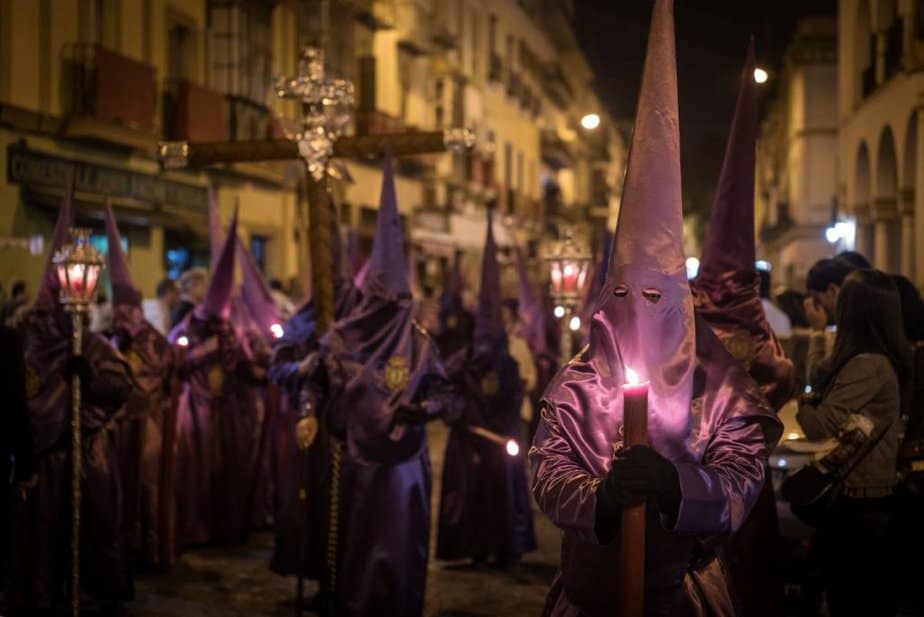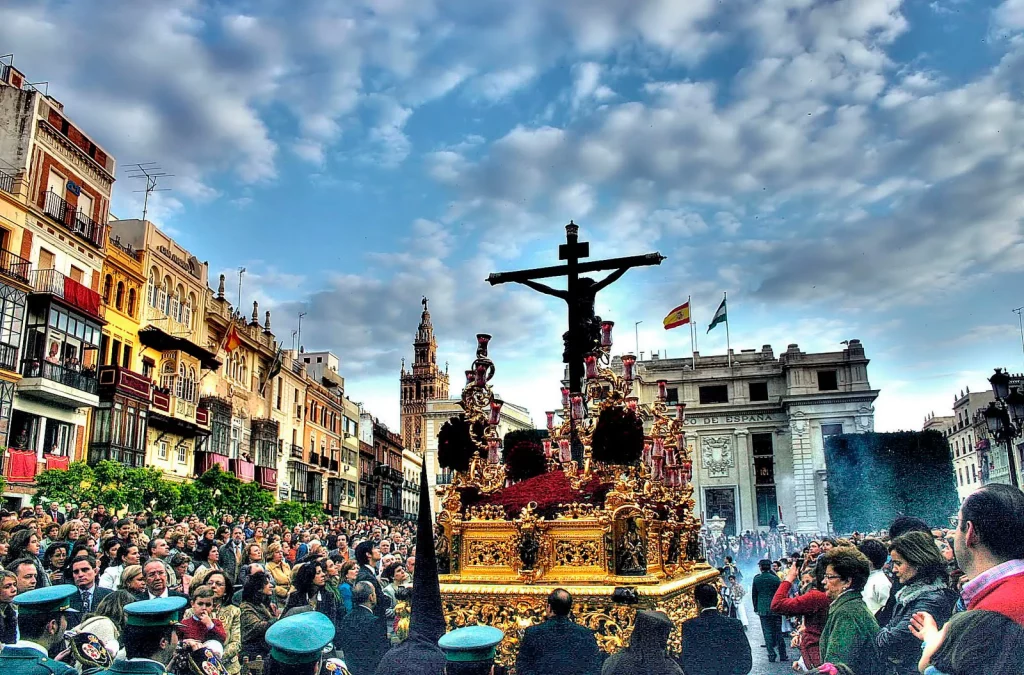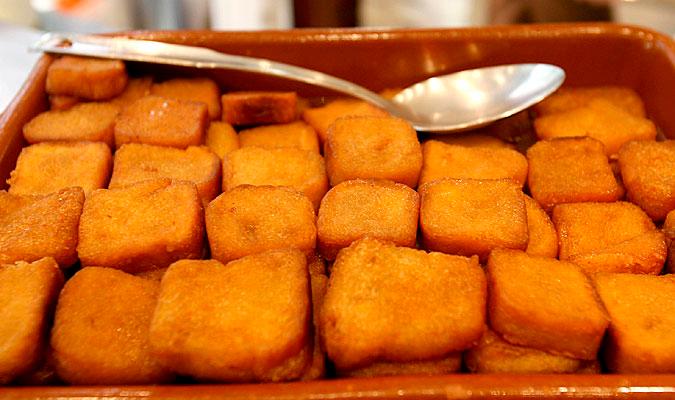Deprecated: mb_convert_encoding(): Handling HTML entities via mbstring is deprecated; use htmlspecialchars, htmlentities, or mb_encode_numericentity/mb_decode_numericentity instead in /home/u211400686/domains/tripinspain.com/public_html/wp-content/themes/acabado/functions.php on line 2149
Sevilla, Spain is the place to be for an unforgettable Easter experience. Over the seven days preceding Easter Sunday, Christians across the world celebrate Semana Santa in Seville, sometimes known as "Holy Week," with elaborate processions, vibrant music, and a generally upbeat mood.

Content
- What is Semana Santa?
- The History of Semana Santa in Seville
- The Processions
- The Costumes
- The Food
- The Atmosphere
- Tips for Visiting Seville During Semana Santa
- When are the Semana Santa dates in 2023?
- Semana Santa in Seville dates for the next 10 years
- Conclusion
- FAQs
- Best Things to do in Seville
What is Semana Santa?
Semana Santa is a traditional Catholic celebration of the passion and death of Jesus Christ. It is observed in many countries, but it is incredibly grand and extravagant in Spain. In Seville, the celebration begins on Palm Sunday and continues until Easter Sunday.

The History of Semana Santa in Seville
The tradition of Holy Week in Seville dates back to the 16th century when religious brotherhoods were formed to celebrate the Passion of Christ. These brotherhoods are responsible for organizing the processions during Holy Week. The first procession in Seville was held in 1521.

The Processions
The processions are the highlight of Semana Santa in Seville. They feature elaborately decorated floats, called pasos, which depict scenes from the Passion of Christ. The pasos are carried through the streets by costaleros, or bearers, who support the weight of the float on their shoulders.
Each procession is organized by a different brotherhood, and Seville has more than 50 brotherhoods. The spectacles can last for hours, accompanied by solemn music and incense.

The Costumes
Costaleros: Carrying the float through the streets of the city are the costaleros, so-called for the white protective cloth (el costal) they wear on their heads. These neighbourhood men are brothers in the church. Twenty to forty costaleros make up a float, and they train year-round, even in August's searing heat.
Nazarenos: Other participants in the processions include the nazarenos, wearing perhaps the most controversial dress of the celebration. The robe worn by these penitents doesn’t draw much attention. The same can not be said for the conical hood (capirote) which bears a striking resemblance to the dress worn by the K.K.K. Rest assured, no connection exists between the two traditions.

The Food
Holy Week in Seville is also a time for indulging in traditional foods. One popular dish is torrijas, similar to French toast but soaked in wine or honey before being fried. Other popular foods include potaje de vigilia, a chickpea stew, bacalao, or salt cod.

The Atmosphere
During Holy Week in Seville, the mood is electrifying. The streets are busy with people and visitors, with distinct excitement. The processions are solemn and severe, yet there is also a sense of delight and celebration.

Tips for Visiting Seville During Semana Santa
If you're planning to visit Seville during Holy Week, here are a few tips to help you make the most of your trip:
- Book your accommodations well in advance, as hotels and apartments fill up quickly.
- Be prepared for large crowds, especially during the processions.
- Dress appropriately, as the weather can be unpredictable and the processions can last for hours.
- Be respectful during the processions and avoid loud or disruptive behavior.
- Try the traditional foods of Semana Santa, such as torrijas and potaje de vigilia.
Semana Santa 2024 Dates: When Does Holy Week Fall This Year?
In 2024, from March 24th to March 31st.
The Holy Week always lasts for 7 days, starting and ending on Sunday.
Semana Santa in Seville dates for the next 10 years
To make things easier, here’s a list of the Holy Week in Seville dates for the next few years. It will help you plan your holidays in Seville – Semana Santa is peak season!
- In 2025, from April 13th to April 20th.
- In 2026, from March 29th to April 5th.
- In 2027, from March 21st to March 28th.
- In 2028, from April 9th to April 16th.
- In 2029, from March 25th to April 1st.
- In 2030, from April 14th to April 21st.
- In 2031, from April 6th to April 13th.
- In 2032, from March 21st to March 28t.
- In 2033, from April 10th to April 17th.
Conclusion
Easter is celebrated in a distinctive and lively style during Holy Week in Seville. There is something for everyone to appreciate, from the elaborate processions to the regional cuisine. If you want to spend the occasion in a novel way, Sevilla is the place to be.
FAQs
Semana Santa is a traditional Catholic celebration of the passion and death of Jesus Christ.
Semana Santa in Seville features elaborate processions, lively music, and traditional foods.
Semana Santa in Seville begins on Palm Sunday and continues until Easter Sunday.
The processions feature elaborately decorated floats, called pasos, which depict scenes from the Passion of Christ. The pasos are carried through the streets by costaleros, or bearers, who support the weight of the float on their shoulders. Each procession is organized by a different brotherhood.
The costaleros wear traditional robes and capirotes, or pointed hoods, which cover their faces. The Nazarenos also wear robes and hoods, but their hoods are conical and don't cover their faces.
Some traditional foods include torrijas, potaje de vigilia, and bacalao.
Be prepared for large crowds, dress appropriately, and be respectful during the processions. It's also a good idea to book your accommodations well in advance.
